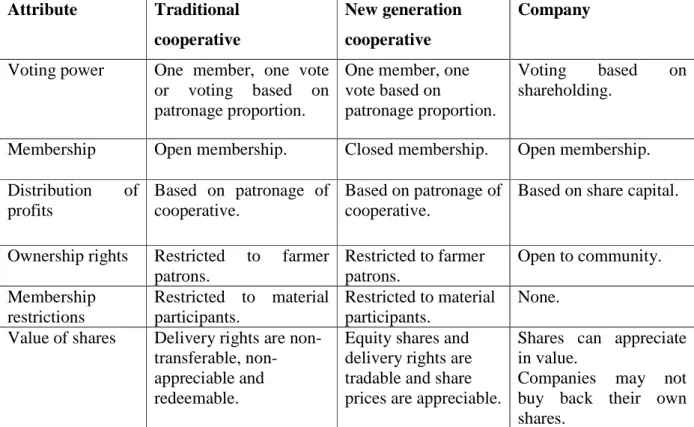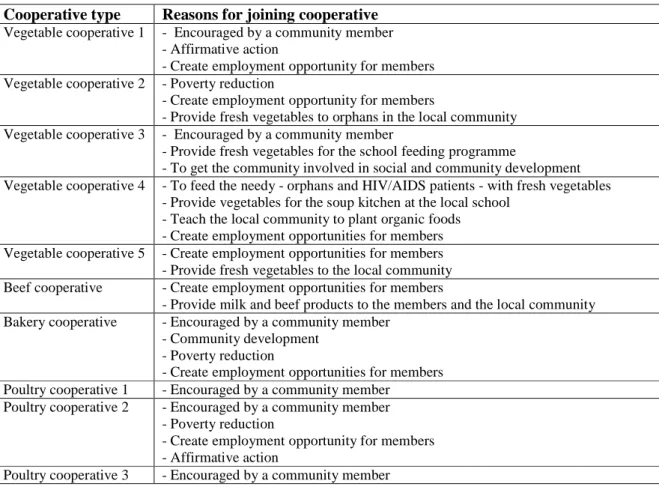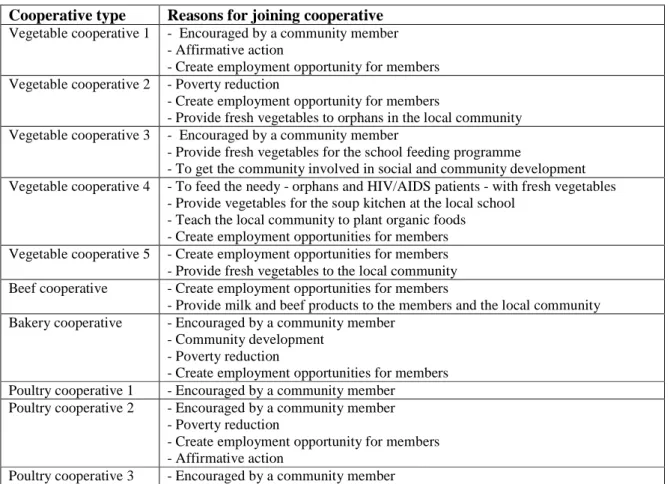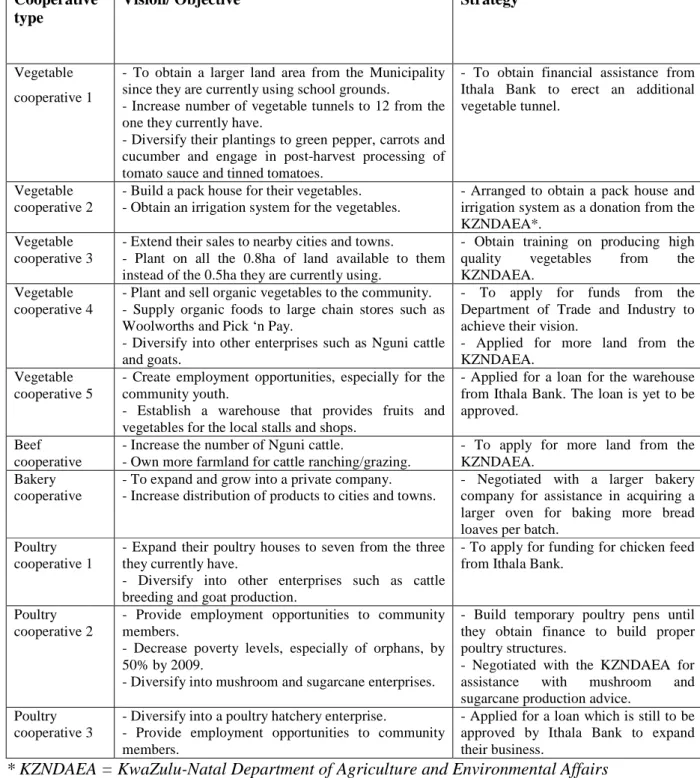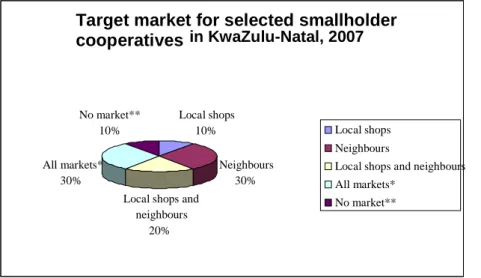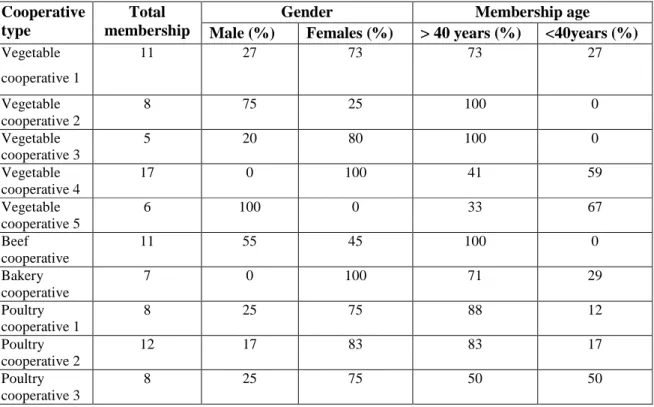Information from the interviews shows that the members of the selected smallholder cooperatives do not fully understand the cooperative principles and have high expectations of the potential benefits of their membership. The results of a cluster analysis suggest that the performance of the selected smallholder cooperatives is influenced by institutional and governance issues. Alternative ownership structures such as closely held partnerships and. private companies offer better institutional arrangements and opportunities for equity sharing partnerships. i) The research in this thesis is, unless otherwise stated, my original research. ii).
41 Table 4.2: Members' reasons for joining the selected cooperatives, KwaZulu-Natal, 2007.42 Table 4.3: Vision/objectives and strategies of selected smallholder cooperatives, KwaZulu-. This study focuses on the effects of institutional and governance factors on the performance of selected small agricultural cooperatives in KwaZulu-Natal (KZN). The aim of this study is to gain a better understanding of the characteristics of small farming cooperatives in KZN and to identify institutional and governance constraints that affect their performance through in-depth analysis of 10 case studies.
- Definitions and principles of a cooperative
- Cooperative typology
- Origin of agricultural cooperatives
- Cooperatives in developed countries
- Cooperatives in developing countries
- The role of agricultural cooperatives
- A comparison of traditional cooperatives, new generation cooperatives and
- Institutional flaws of traditional cooperatives
- Free-rider problem (or problem with common ownership)
- Horizon problem
- Portfolio problem
- Control problem
- Influence cost problem
Traditionally, many cooperatives focused on three main areas of business: (1) buying and selling agricultural inputs and equipment;. 2) purchase, storage and subsequent sale of agricultural products; and (3) transportation services (Piesse et al., 2003; cited in Ortmann and King, 2007a). Modern cooperatives emerged in Europe in the late 19th century, during the Industrial Revolution (Hoyt, 1989; cited in Ortmann and King, 2007a). The history of cooperatives in China dates back to the early twentieth century, when cooperatives emerged in some parts of China in the 1920s (Hu et al., 2006).
Most agricultural cooperatives in developing countries focus more on product marketing and input supply than on production (Ortmann and King, 2006). In the case of South Africa, agricultural cooperatives in the former homelands were generally unsuccessful. In South Africa, for example, cooperatives have historically dominated the distribution of agricultural inputs and intermediate products such as seed, fertilizer, fuel and repair services.
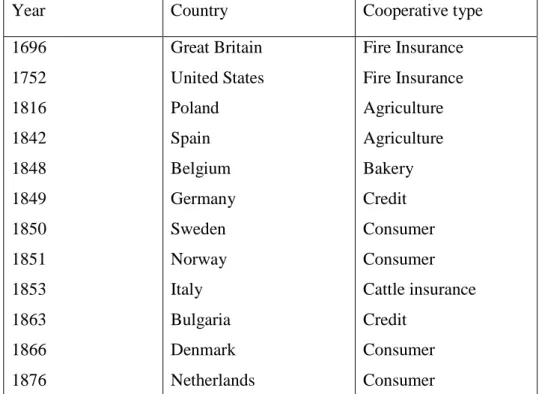
- Introduction
- Definitions of performance, institutions and governance
- Characteristics of smallholder farmers in South Africa
- Some institutional and governance problems influencing the performance
- Theory of New Institutional Economics (NIE)
- Transaction cost economics
- Agency theory
- Collective action theory
- Property rights theory
- Application of the New Institutional Economics framework to cooperatives. 31
According to IFAD (2003), market access can be defined in three dimensions: physical access to markets (distance, transport costs, etc.); the structure of markets (asymmetry of relations between farmers, market intermediaries and consumers); and lack of skills, information and organization of producers. Agricultural cooperative performance is usually evaluated according to cooperative goals, many of which are created for economic reasons, such as promoting the financial sustainability of cooperative members (Machethe, 1990). However, the performance of cooperatives in previous countries was generally unsatisfactory, regardless of the standard used (Machethe, 1990).
The term "New Institutional Economics" was first coined by Williamson (1985) but emerged with Coase's 1937 article "The Nature of the Firm". The transaction cost approach was first introduced by Ronald Coase (1937) in his article "The nature of the firm" and formulated by Williamson in 1965. One route through which institutions ("rules of the game") can affect cooperative performance is through its effects on the structure of cooperatives and the efficiency with which they function.
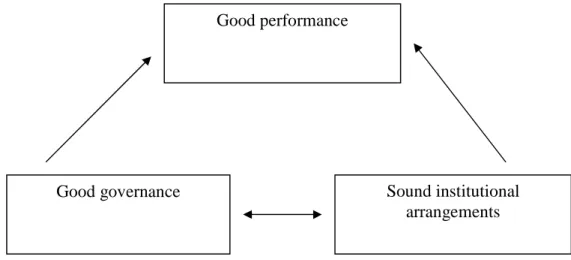
- Introduction
- Research objectives and hypotheses
- Research objectives
- Research hypotheses
- Data collection
- Sampling procedure and study areas in KZN
- Study data collection and questionnaire design
- Pre-testing and implementation
- Analytical tools
- Descriptive statistics
- Cluster analysis
Ten small farming cooperatives in KZN were selected for detailed case studies in this study. An updated list of the names of small farming cooperatives in KZN was obtained from the KwaZulu-Natal Department of Agriculture and Environmental Affairs (KZNDAEA), which works closely with these cooperatives. Five of the selected cooperatives were from EThekwini District, three from Msunduzi District and two from Camperdown District.
Personal interviews were conducted with chairpersons, management committee and other cooperative members of the selected cooperatives in relation to a structured questionnaire to obtain qualified responses. The first part of the questionnaire (see Annex 4, Section A) asks for general information about the cooperative: formation, registration and functioning of the cooperative. The purpose of the pretest was to assess the relevance, validity and cultural acceptability of the questions.
The pilot study proved useful because some questions that seemed ambiguous were then rephrased so that future respondents could better understand them. This section presents the analytical framework used in this study to assess the factors influencing the performance of small agricultural cooperatives in KZN. Descriptive statistics were used to characterize and understand the structure of selected small agricultural cooperatives in KZN.
Cluster analysis can be used for a variety of purposes (Aldenderfer and Blashfield, 1984:9); e.g. (1) to develop typologies or classifications, (2) to generate concepts or hypotheses by exploring the data, and (3) to test whether typologies or classifications created by other processes or using other data are present in the data set. Considered. Cluster analysis has been used in the field of medicine, clustering diseases, drugs for diseases or symptoms of diseases (Harrigan, 1985). In the field of life sciences, the subjects of cluster analysis are life forms such as plants, animals, insects, cells, and microorganisms.
In this study, a cluster analysis will be conducted on the variables obtained from the completed questionnaires to determine the institutional and governance factors that influence the performance of smallholder cooperatives in KZN.
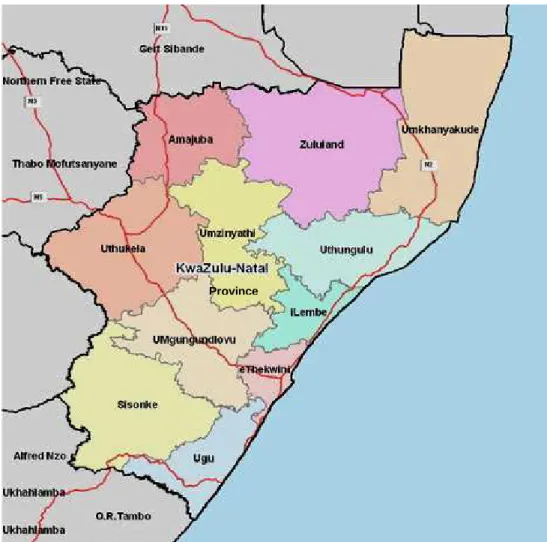
- Introduction
- Description of selected cooperatives
- Structure and organisation of selected cooperatives
- Vision and objectives
- Gender and membership composition of selected cooperatives
- Characteristics of cooperative chairpersons of selected cooperatives
- Financial management of selected cooperatives
- Banking
- Turnover and distribution of net surplus
- Growth
- Auditing
- Government assistance needed by selected cooperatives
- General management and leadership
- Production capacity
- Financial assistance and management
- Marketing
For example, the chairman of the beef cooperative stated that their members joined for reasons of job creation and to provide meat and milk products to the members and the local community. Nine of the selected cooperatives had asset growth as one of their long-term goals. The target market for 30% of the selected cooperatives was their neighbors (Figure 4.1), which are people living around the cooperative area.
Four of the selected cooperatives (vegetable cooperatives 1 and 3, bakery cooperative and poultry cooperative 1) received loans from Ithala Bank guaranteed by KZNDAEA, while the others are still waiting for their loans to be approved. The levels of capital contributed by the members of the selected cooperatives depended on what each member could afford at the time the cooperative was established. Most of the selected cooperatives currently finance their activities from government donations and sales turnover.
Nine of the case studies obtained at least some of their seed capital from the government in the form of a grant and/or donation. All the selected cooperatives cited limited equity capital and debt capital to finance growth assets as factors influencing their performance in terms of growth and diversification. The bakery co-operative had a turnover of R180 000 in 2006/07 and the beef co-operative was generating no income at the time of the study as the co-operative was still raising cattle.
According to the chairmen of all selected cooperatives, the Treasurer manages the financial affairs of the cooperative. Seven of the selected cooperatives perform internal audit while only three cooperatives use external auditors. In addition, five of the selected cooperatives answered that they needed accounting training for management.
The presidents of the five selected vegetable cooperatives indicated that they needed training on the general management and administration of their cooperative.
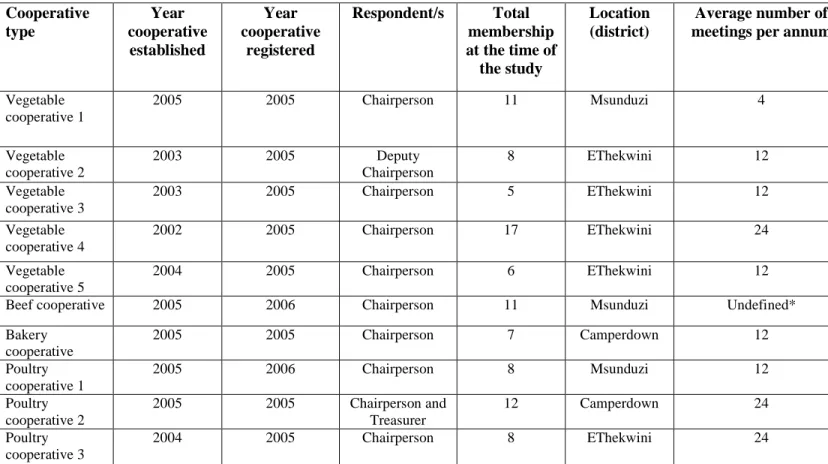
Introduction
Cluster analysis
Institutional, governance and performance indicators
- Cluster 1
- Cluster 2
Under the Cooperative Act 2005, an audit of the affairs of a co-operative must be carried out annually to ensure that the annual accounts are prepared in accordance with generally accepted accounting practices. Perhaps this is because the cooperatives complied with the good governance requirements of the new Cooperative Act and also with poor institutional arrangements. Propsurp indicates an internal free-rider problem, which arises when cooperative members are rewarded for patronage even though they invest very little in the cooperative.
This means that education is positively correlated with good institutional arrangements, which suggests that education is a prerequisite for the use of good institutions ('rules of the game'). All the selected cooperatives obtained at least part of their founding capital from the state. The results of the cluster analysis of variables measuring three constructs (comprising performance indicators, institutional and management indicators) show that the performance of the 10 selected small cooperatives was affected by institutional and management problems.
The history of cooperatives goes back more than 160 years (for example, the consumer cooperative Rochdale Equitable Pioneers' Society was established in England in 1844). This study presents an overview of the factors influencing the performance of 10 selected small farming cooperatives (case studies) in KZN. The nature and extent of these problems in any context is a function of the institutional arrangements reflected in an organization's constitution.
Five of the selected cooperatives were from EThekwini District, three from Msunduzi District and two from Camperdown District in KZN. The survey results show that the members of the selected cooperatives generally do not understand the guiding principles of a cooperative. They have high expectations of the potential benefits of establishing a cooperative, which poses institutional and managerial challenges.
The results of the cluster analysis of variables measuring three constructs (comprising performance indicators, institutional and management indicators) show that the performance of the 10 selected small cooperatives was affected by institutional and management problems. Measuring organizational performance without objective measures: The case of a private company and a business unit of a conglomerate. Paper presented at the 41st Annual Conference of the Agricultural Economics Association of South Africa (AESA), October Pretoria, South Africa.
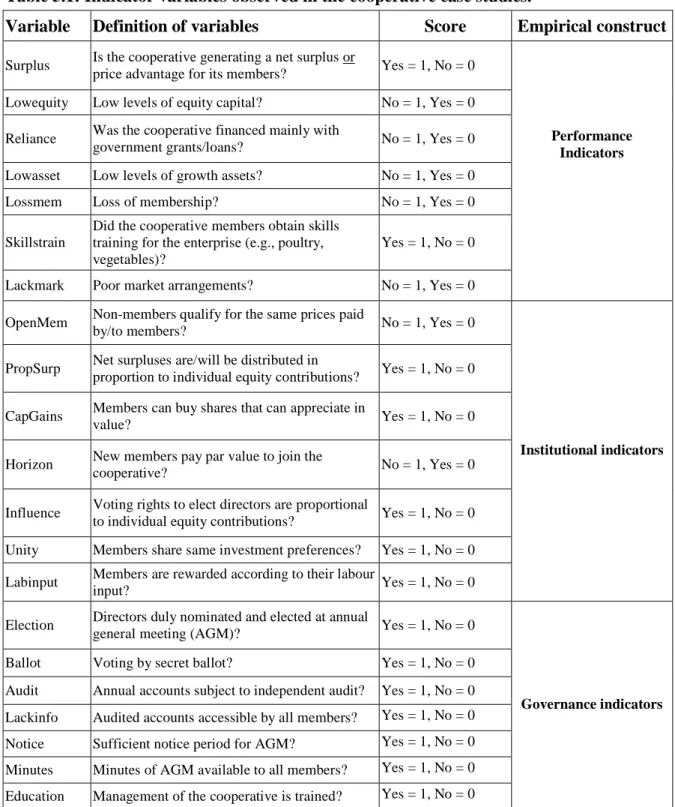
Principles of cooperatives
Cooperative scores on institutional indicators
Cooperative scores on governance indicators
Questionnaire
What is the current composition of your cooperative membership in terms of gender and age. What are the minimum experience and business skills the chairman needs to lead the cooperative? What are the minimum experience and business skills the manager needs to lead the cooperative?
What is the value of your debt and equity held by the cooperative currently? On average, what is the cooperative's total turnover (gross income) from all enterprises per year. What is the turnover for each enterprise in which your cooperative is involved and how has it changed in the past.
Has the cooperative ever considered working together with another organization (joint venture) to add value to production through storage, processing, branding and labeling? .. b) If YES, how did you plan to achieve this and justify the chosen criteria. Have you considered converting your cooperative to an investor-owned firm (eg, new generation cooperative, private company). What services and products does your cooperative intend to produce and sell in the future.
